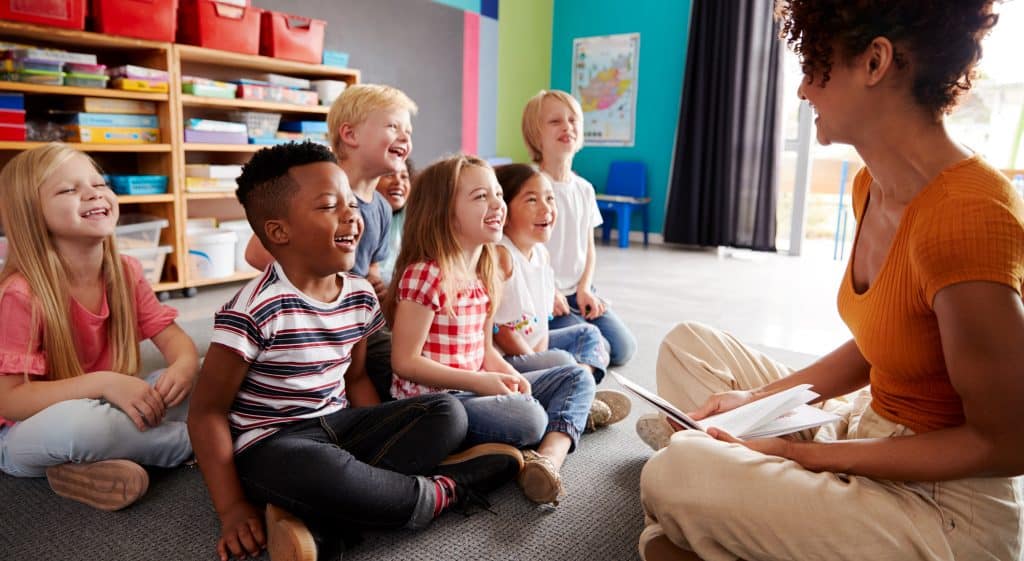Plan School and District Curriculum Informed by the Science of Reading
Join Waterford’s Science of Reading Summit, presented by Senior Director of Curriculum Julie Christensen, to learn about research-based literacy development strategies you can apply at the classroom, school, or district level.
Plus, find upcoming and on-demand video series led by early education experts through Waterford’s Webinar Library, featuring topics chosen with administrators in mind like:
- Impactful Family Engagement Made Easy
- Understanding the Six Literacy Strands
- Improving Student Outcomes with Professional Services
Understanding the science behind how children learn to read is the starting point for creating effective, well-grounded classroom instruction. Cognitive psychologists, neuroscientists, and education experts have studied literacy development for decades, resulting in a wealth of information for educators. One of the most well-known, concise, and grounded models of literacy development is the Simple View of Reading, a framework that represents reading proficiency as the product of two factors.
Read on to learn more about the Simple View of Reading and how it can inform your classroom instruction—along with ten free activities to help your students practice key early literacy skills.
What is the Simple View of Reading?
The Simple View, developed by Philip B. Gough and William E. Tunmer in the 1980s, identifies two key areas of proficiency for literacy development: word recognition and language comprehension.[1] When these two factors work in tandem, reading comprehension is the result.
What do the words SAY?
Word recognition skills allow students to identify words with accuracy, first through the decoding process and later automatically. Proficiency with word recognition skills is a prerequisite for automatic, fluent reading.
What do the words MEAN?
A student’s language comprehension skills represent their ability to understand language. These skills are largely dependent on a student’s breadth and depth of both vocabulary and background knowledge.

Together, strong word recognition and language comprehension skills lead to proficient reading comprehension.
The Simple View of Reading is notable because it recognizes that word recognition and language comprehension work together, not in isolation. For decades, the “Reading Wars” debated which of the two components should be at the center of instruction. [2] But effective instruction emphasizes both.
Simple View of Reading vs. Scarborough’s Reading Rope
Scarborough’s Reading Rope is another literacy acquisition model that identifies the skills necessary for learning to read. Developed by Hollis Scarborough in 2001, it extends the Simple View by identifying subskill areas for language comprehension, which fosters strategic reading, and word recognition, which fosters automatic reading.
Today, many educators understand that word recognition skills and language comprehension skills are equally foundational. And the research shows that direct, explicit instruction in both areas is essential for many students, and beneficial for all.
The free resources linked below are designed by the Waterford Curriculum team and guided by the science of reading. They are also great supplemental activities to send home for families!
5 Classroom Activities for Building Word Recognition Skills
1. Use these capital letter and lowercase letter cards to help young learners build letter recognition skills.
2. Sing this engaging Tongue Twister ABCs song together to teach letter-sound connections.
3. Use this activity, Where’s the Sound? (Spanish: Donde esta el sonido?), to help students identify the positions of sounds within words.
4. These word pattern cards (Spanish: Tarjetas de patrón de palabras) can be used to help students map letter to sounds in words with common spelling patterns.
5. Give students the opportunity to apply their phonics skills with this decodable book, Pat Can Camp (Spanish: Pat puede acampar).
5 Classroom Activities for Building Language Comprehension Skills
1. This guided reading video provides students with helpful background knowledge to support their comprehension of The Little Red Hen (Spanish: La Pequeña Gallina Roja).
2. This foldable book, Opposites (Spanish: Opuestos), can serve as a springboard for teaching more complex vocabulary word pairs.
3. This sentence starters activity (Spanish: Inicio de oraciones) helps students develop language skills as they share their ideas through writing.
4. Share a read-aloud of The Three Little Pigs (Spanish: Los Tres Cochinitos) with your students. Then use the ideas outlined in this classroom resource to build language and communication skills that support reading development.
You can also share the narrated book (Spanish) with families along with this guided activities resource (Spanish) designed for learning at home.
5. For students who are ready for chapter books, share Violeta (Spanish), an early reader story about a shy student who discovers the joy of sharing her voice.
Read Waterford’s Science of Reading article series to learn about research-based instructional strategies for creating classroom lesson plans. Get started with:
Sources:
1. Christensen, J. “The Science of Reading: From Research to Instruction.” Waterford.org, April 2022.
2. Castles, A., Rastle, K., and Nation, K. “Ending the reading wars: Reading acquisition from novice to expert.” Psychological Science in the Public Interest, 2018, vol. 19, 5–51. https://journals.sagepub.com/doi/full/10.1177/1529100618772271
Gough, P., & Tunmer, W. (1986). Decoding, reading, and reading disability. Remedial and Special Education, 7, 6–10.
Scarborough, H. S. (2001). Connecting early language and literacy to later reading (dis)abilities: Evidence, theory, and practice. In S. Neuman & D. Dickinson (Eds.), Handbook for research in early literacy. New York: Guilford Press.

